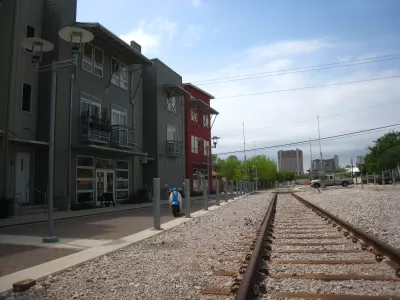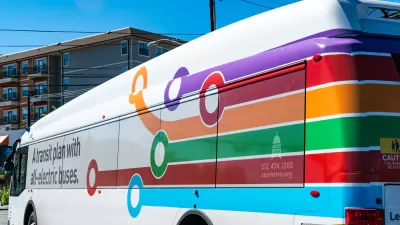New research about the importance of transit in building transit oriented communities has some surprising results that may have significant implications for how we plan and build in the future.

Writing in The Urban Edge, Andrew Keats reports on new research from UC-Berkeley professor Daniel Chatman that looks at what makes a successful transit oriented development. Surprisingly, he finds that proximity to transit (specifically light rail stations) has little impact on the success of TOD projects.
The study focused on people living within 0.4 miles of transit and in homes less than 7 years old, "essentially a proxy for those who live in 'transit-oriented development'." What it found was that those people owned fewer cars and were less likely to drive to work. However, the placement of a transit station nearby wasn’t the most influential factor in creating successful TOD development.
Rather, the most important factors were the scarcity of parking and the number of bus stations in the vicinity. Neighborhoods with little parking and lots of bus service cut car ownership by 44 percent.
“When all of these other factors were considered (bus access, parking availability, job and population density, and housing type), rail access had no effect on auto ownership,” Chatman wrote.
…
What really mattered was scarce parking, ample bus service, smaller apartments, more rental apartments, more stuff within walking distance, and being close to downtown jobs.
Chatman writes that cities without those, expensive light rail stations can still have the successful type of neighborhoods that transit oriented development has promised, but changes to policy need to take place. Among Chatman's suggestions, reducing parking requirements for new projects and encouraging density, while planning for amenities such as grocery stores, can achieve many of the goals espoused by TOD advocates.
FULL STORY: Why Transit Oriented Development Doesn’t Need Transit

Alabama: Trump Terminates Settlements for Black Communities Harmed By Raw Sewage
Trump deemed the landmark civil rights agreement “illegal DEI and environmental justice policy.”

Study: Maui’s Plan to Convert Vacation Rentals to Long-Term Housing Could Cause Nearly $1 Billion Economic Loss
The plan would reduce visitor accommodation by 25% resulting in 1,900 jobs lost.

Why Should We Subsidize Public Transportation?
Many public transit agencies face financial stress due to rising costs, declining fare revenue, and declining subsidies. Transit advocates must provide a strong business case for increasing public transit funding.

Paris Bike Boom Leads to Steep Drop in Air Pollution
The French city’s air quality has improved dramatically in the past 20 years, coinciding with a growth in cycling.

Why Housing Costs More to Build in California Than in Texas
Hard costs like labor and materials combined with ‘soft’ costs such as permitting make building in the San Francisco Bay Area almost three times as costly as in Texas cities.

San Diego County Sees a Rise in Urban Coyotes
San Diego County experiences a rise in urban coyotes, as sightings become prevalent throughout its urban neighbourhoods and surrounding areas.
Urban Design for Planners 1: Software Tools
This six-course series explores essential urban design concepts using open source software and equips planners with the tools they need to participate fully in the urban design process.
Planning for Universal Design
Learn the tools for implementing Universal Design in planning regulations.
Smith Gee Studio
Alamo Area Metropolitan Planning Organization
City of Santa Clarita
Institute for Housing and Urban Development Studies (IHS)
City of Grandview
Harvard GSD Executive Education
Toledo-Lucas County Plan Commissions
Salt Lake City
NYU Wagner Graduate School of Public Service




























